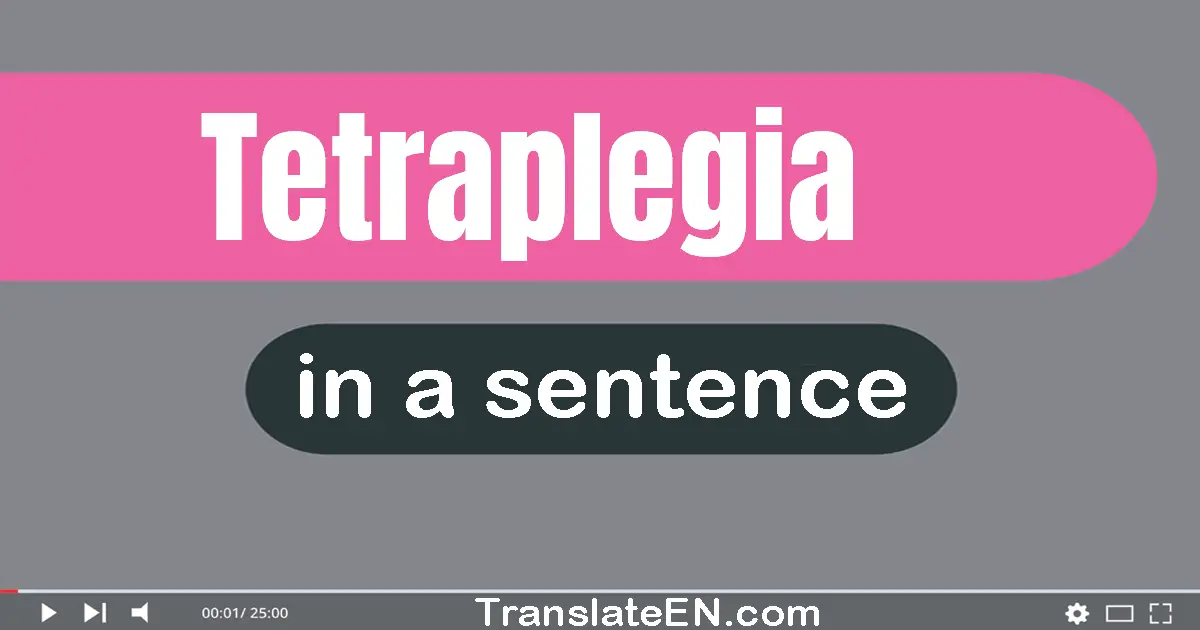Tetraplegia in a sentence
Synonym: quadriplegia, paralysis.
Meaning: Paralysis of all four limbs.

(1) Tetraplegia is often caused by a spinal cord injury.
(2) Tetraplegia is a condition that affects all four limbs.
(3) Tetraplegia requires ongoing medical care and management.
(4) The severity of tetraplegia can vary from person to person.
(5) Rehabilitation is an important part of managing tetraplegia.
(6) The road to recovery from tetraplegia can be long and challenging.
(7) Tetraplegia can result in muscle spasms and involuntary movements.
(8) Living with tetraplegia requires significant adaptations and support.
(9) Tetraplegia is a condition that affects all four limbs and the torso.
(10) People with tetraplegia may require assistance with daily activities.
Tetraplegia sentence
(11) Tetraplegia can be caused by traumatic accidents or medical conditions.
(12) Tetraplegia can result in respiratory and cardiovascular complications.
(13) Tetraplegia can have a significant impact on a person's quality of life.
(14) The patient was diagnosed with tetraplegia after a severe spinal cord injury.
(15) Tetraplegia can result in loss of sensation and motor function below the neck.
(16) Tetraplegia can result in chronic pain and require pain management strategies.
(17) The accident left him with tetraplegia, unable to move anything below his neck.
(18) There is currently no cure for tetraplegia, but treatment options are available.
(19) Assistive devices such as wheelchairs are often used by individuals with tetraplegia.
(20) Individuals with tetraplegia may require assistance with mobility and transportation.
Tetraplegia make sentence
(21) Rehabilitation programs can help individuals with tetraplegia regain some independence.
(22) Tetraplegia can impact respiratory function and require specialized medical interventions.
(23) The emotional impact of tetraplegia can be profound and may require psychological support.
(24) Adaptive sports and recreational activities can be enjoyed by individuals with tetraplegia.
(25) Tetraplegia can result in significant changes to a person's personal and professional life.
(26) Support groups can provide emotional and practical support for individuals with tetraplegia.
(27) Tetraplegia affects not only physical abilities but also daily activities and quality of life.
(28) Physical therapy is an essential component of rehabilitation for individuals with tetraplegia.
(29) Assistive technology plays a crucial role in enhancing independence for those with tetraplegia.
(30) Tetraplegia can affect a person's ability to perform self-care tasks such as bathing and dressing.
Sentence of tetraplegia
(31) Tetraplegia can affect a person's ability to participate in social activities and community events.
(32) Occupational therapy can help individuals with tetraplegia regain skills necessary for daily living.
(33) The prognosis for individuals with tetraplegia varies depending on the severity and underlying cause.
(34) Adaptive housing modifications may be necessary for individuals with tetraplegia to live independently.
(35) Tetraplegia can lead to secondary health complications such as pressure sores and urinary tract infections.
(36) The support of family and friends is crucial for individuals with tetraplegia to navigate daily challenges.
(37) Tetraplegia can be a challenging condition to live with, but many people with the condition lead fulfilling lives.
Tetraplegia meaning
Tetraplegia is a medical term used to describe a condition in which a person experiences paralysis in all four limbs, typically resulting from a spinal cord injury. It is important to understand how to use this word or phrase correctly in a sentence to ensure effective communication. Here are some tips on how to incorporate "tetraplegia" into your writing:
1. Define the term: When introducing the word "tetraplegia" in your sentence, it is helpful to provide a brief definition or explanation.
For example, "Tetraplegia, also known as quadriplegia, refers to the paralysis of all four limbs due to a spinal cord injury."
2. Use it in a medical context: Tetraplegia is primarily used in medical and scientific discussions. When using the word in a sentence, make sure the context aligns with its medical meaning. For instance, "The patient was diagnosed with tetraplegia after a severe car accident."
3. Be clear and concise: When incorporating "tetraplegia" into your sentence, strive for clarity and conciseness. Avoid using overly complex language or unnecessary jargon. Instead, opt for straightforward and easily understandable phrasing.
For example, "John's tetraplegia prevents him from independently performing daily tasks."
4. Provide additional information: If necessary, include additional details to enhance the reader's understanding of the term. This can be achieved by elaborating on the causes, symptoms, or treatment options associated with tetraplegia. For instance, "Tetraplegia can result from traumatic injuries, such as falls or sports accidents, and may require extensive rehabilitation and assistive devices for mobility."
5. Use appropriate grammar and syntax: Ensure that the sentence structure and grammar are correct when incorporating "tetraplegia." Pay attention to subject-verb agreement and proper tense usage.
For example, "She has been living with tetraplegia for over a decade."
6. Consider the audience: Tailor your sentence to suit the intended audience. If you are writing for a medical journal or professionals in the field, you can use more technical language. However, if your audience is general readers, it is best to use simpler terms and provide explanations when necessary.
7. Avoid offensive language: When discussing tetraplegia, it is crucial to be sensitive and respectful. Avoid using derogatory or offensive terms that may stigmatize individuals with this condition. Instead, focus on promoting understanding and empathy.
In conclusion, using the word "tetraplegia" correctly in a sentence requires an understanding of its medical context, clear and concise language, and consideration for the intended audience. By following these tips, you can effectively incorporate this term into your writing and communicate your message accurately.
The word usage examples above have been gathered from various sources to reflect current and historical usage of the word Tetraplegia. They do not represent the opinions of TranslateEN.com.
